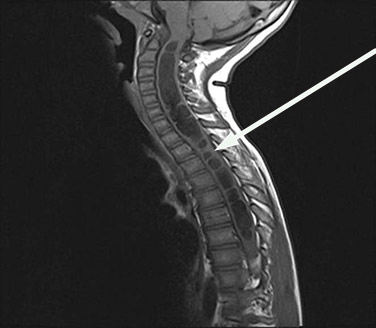Syringohydromyelia
Syringohydromyelia is a term often used in radiology reports to describe a condition where excess cerebrospinal fluid is present within the spinal cord. Often this condition may be termed as a “syrinx.”
Your physician will focus on important points in the history, physical exam and radiographic studies of your child.
History:
- Does your child have back pain?
- Does your child have any weakness or numbness in the arms or legs?
- Does your child have any headaches?
- Does your child have any curvature in their spine?
- Does your child have any problems with their bladder function?
- Is there any history of spinal trauma or spinal infections?
Physical exam
- Is there any evidence of an abnormal neurological exam?
- Is there any scoliosis?
- Are the feet the same size?
MRI imaging
- Is the syrinx large or small (a few millimetres)?
- Is the spinal cord expanded?
- Are there any abnormalities at the cranio-cervical junction?
- Is there any evidence of a low-lying spinal cord?
- Has the syrinx been growing?
How is a syrinx diagnosed?
MRI scans have been very beneficial in improving the ability to both detect and closely monitor these collections. Once a fluid collection is identified, it is usually prudent to image the entire nervous system to look for associated abnormalities.

Example of a cervical thoracic syrinx
What causes syrinx?
The exact cause of syringohydromyelia is unknown. On many occasions the syrinx may be the result of abnormal spinal cerebrospinal fluid dynamics. This condition may be idiopathic (no known cause), or secondary to trauma, hydrocephalus, Chiari malformation, tethered spinal cord, and an intramedullary spinal cord tumour.
What are the symptoms of syrinx?
Most children with a syringohydromyelia are asymptomatic and are diagnosed incidentally during a neuroimaging procedure. Symptoms of a syringohydromyelia may be due to the direct pressure on the spinal cord from the fluid collection. Therefore, the symptoms will be related to the level in the spinal cord where the syringohydromyelia is located. Common symptoms include weakness, numbness, pain, incontinence and scoliosis.
The MRI image above demonstrates a cervical-thoracic syringohydromyelia.
Treatment of syringohydromyelia
If the syrinx is creating symptoms, the first treatment is to address the underlying cause of the syrinx. If there is a Chiari malformation or a tethered cord that is causing the syrinx, then the underlying cause will be treated.
In the majority of cases the syrinx does not direct treatment. If your child has a small thoracic syrinx with no symptoms the neurosurgeon may elect to follow your child with repeat physical exams and/or neuroimaging.
Direct treatment of the syrinx can involve redeveloping a normal spinal subarachnoid space or draining the syrinx to the spinal subarachnoid space or via a shunt construct to the pleural or peritoneal space.
Direct tubes in the spinal syrinx can be problematic due to blockage, migration or infection. There is no one superior treatment and the neurosurgeon will determine which will be indicated in your child’s specific condition. The surgeries are typically well tolerated and in many cases, children recover fully. Follow-up MRIs will likely be performed after the surgery.

